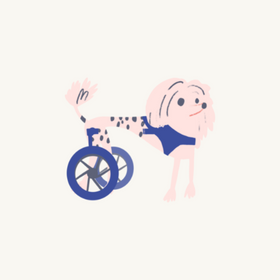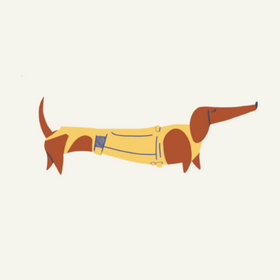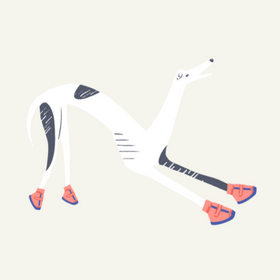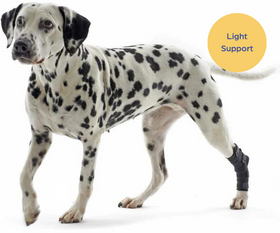01730 622544

How Often Should You Cut Dogs Nails When They Are Older
What Affects Older Dogs Nail Growth and Trimming Frequency?
Many factors affect how fast your individual senior dog's nails grow, so unfortunately there is no quick answer for how often you should cut them. While on average most dogs will need to have their nails trimmed every 1-2 months, it can be more frequently even as often as once per week for senior dogs. There are two main factors to take into account when determining how quickly your senior dog's nails are growing, and how often you'll need to trim them. These include:1. Activity Level
Dogs that walk regularly on pavement will naturally have their nails worn down, so they won't need to be trimmed as often. As dogs get into their golden years, however, they tend to slow down overall and may develop diseases that affect their mobility, such as arthritis. This often equals less and/or shorter walks, which means you'll need to trim more often. Keep in mind that even if your senior dog is still active and goes on lots of walks, if they are walking on dirt or grass, their nails won't be worn down as quickly as if they were walking on sidewalks or asphalt.
2. Surface
What type of surface does your dog spend most of their time on? A dog who is mostly indoors walking on carpet will require less frequent nail trimmings than a dog who's walking on tile or spending lots of time on the backyard patio, for instance. Even if you have hard surfaces on your floors or concrete pads in your yard, a senior dog who's losing mobility may spend most of the day lounging on their dog bed and less time walking on these surfaces, which means you'll need to up the amount of nail trimmings.
Guidelines for How Often to Trim Your Dog's Nails
Now that we understand what can affect the frequency of your specific dog's nail trimmings, here are some general guidelines to keep in mind for understanding how often you should cut a dog's nails:- A good rule of thumb is that you should trim your dog's nails as often as it takes to prevent their nails from touching the ground when they're standing.
- If you can hear your dog's nails clicking on the floor, they need to be trimmed.
- Dogs' front nails tend to grow faster than their back nails, so you may not need to cut their rear nails as frequently as their front ones.
Why It's Important to Trim Your Senior Dog's Nails
A dog's nails are important parts of their anatomy. Essentially, having long nails changes the way a dog carries themselves, which can cause damage to their skeletal system. A long nail causes the bones in their foot to flatten and the Metacarpal, Phalanx I, and Phalanx II bones to sit more angled every time the dog walks or stands. This unnatural angle of the bones causes joint stress each time pressure is applied, changing the natural alignment of the leg bones which adds torque or twisting to the joints. Over time, this can lead to arthritis and joint pain. In a senior dog, in which the natural wear and tear of the joints over the years already puts them at risk for these painful diseases, the problem is compounded. If your senior dog already has arthritis, this only adds more pain on top of their current discomfort. The unnatural alignment in your dog's skeletal system caused by overly long nails feels similar to them as it would to you if you had to wear high heels all the time. Plus, long nails can make it difficult for your pup to get a good grip as they walk along slick floors like hardwood or tile, which can already be difficult for a senior dog. Not to mention that long nails are more likely to get caught on things and torn off (ouch!) and are more prone to infection. Luckily, all these issues are completely preventable with basic regular nail trimmings. As long as you follow the guidelines above for how often to cut their nails, you'll save your dog a world of unnecessary discomfort.Tips for Cutting Your Senior Dog's Nails
Now that we know why it's important to clip your dog's nails regularly, here are some of our favorite tips to keep the process as stress-free as possible, for both of you:- Get a quality pair of clippers, and either sharpen or replace them regularly.
- Use only or plier type clippers, which come with a guide that helps you avoid cutting the quick. (Guillotine style clippers crush the toe, which hurts your pup. Never put the whole nail in a clipper.)
- Small size clippers will give you better control. Only giant breed dogs need large ones.
- Hold your dog's paw firmly but gently, and avoid squeezing the toes, which can hurt and cause your dog to squirm even more.
- Cut the nail at a 45-degree angle, taking off small amounts at a time.
- If you accidentally cut the quick, stay calm panicking will only cause your dog to do the same. Even if there's quite a bit of blood, remember your dog will be alright. You can pack a pinch of cornstarch into the end of the nail to stop the bleeding.
- Use lots of verbal praise and tasty treats throughout the process.
- Trim your dog's nails outside or in a well-lit room, and use glasses if you need them.
- If needed, enlist another person to help you with the task. Or if your dog is seriously squirmy, take them to a professional to get the job done safely.

Looking for help with your dog?
We can help find the right solution for your dog
Feel free to give us a call on 01730 622544
or email us at woof@zoomadog.co.uk





